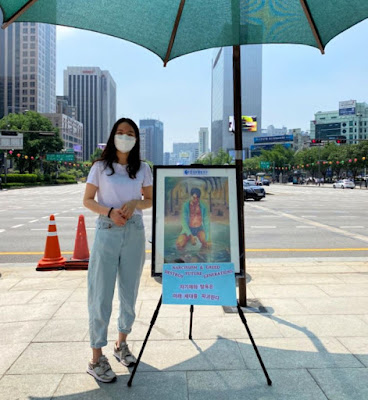Solidarity with World Environment Day Activists
World Environment Day is celebrated around the world annually on June 5. The United Nations first organized this annual event to promote awareness-raising and action for a sustainable environment. This annual celebration is gaining more popularity, support, and action, especially among organizations, groups, individuals, including activists who are campaigning for the protection of all creatures and, are against the historic unsustainable consumption and exploitation of the natural resources.
Much worse, the harsh effects of climate change brought about by environmental degradation are not only caused by overconsumption of resources (worsen by wastes) but also due to integrity issues. Such issues include bribery and corruption involved in logging, mining, development projects, procurement, business permits, among others.
Transparency International (TI), a leading global anti-corruption movement, includes the climate and environmental governance integrity issues as part of its mission. A number of its chapters around the world implement projects tailored to the local needs to counter climate and environment-related integrity and corruption issues.
TI-Korea, aside from our usual anti-corruption activities (e.g., business, youth, open government partnership-OGP), is involved not only in monitoring and providing integrity policy inputs to the Green Climate Fund’s programs and activities but also supporting local actions against climate and environmental integrity issues. One of our acts is picketing and using climate artworks to raise awareness and invite people to support our actions.
In Solidarity with Korean Environmental Defenders
South Korea is famous for its national parks adorned with verdant leaves of trees from which various species of flora and fauna live under their cool canopies. Acres of lands and mountainsides were devastated during the Korean War in the 1950s. By nature’s way, trees grow, and mountains turn green again, although many were planted through extensive and long-term arboreal policies established and efficiently implemented by the government.
At some places, one can find old trees, including on Jeju Island. On this Island, however, recent issues of environmental degradation and losses are ongoing. These issues are being propagated by development and business activities. Luring more tourists to Jeju Island drives the government and businesses to expand the Island’s business facilities, mainly for profits. The domestic and international environmental critics and activists are particularly keen on protecting Jeju Island’s beautiful and natural landscape from eventual destruction through militarization, urbanization, and over-tourism activities.
World Peace Island with a Naval Base
One of the alarming signs of such environmental degradation was the construction of the naval base on Jeju Island. The naval base was finally completed in 2016 despite the resistance from residents, activists, and critics primarily due to an environmental and political basis.
Environmentally, to build the structure and create space for large battleships (aircraft carriers) and such navy weaponry, they had to literally destroy the natural rocks, corals, and everything that could hinder the construction project. Politically, Jeju Island is now a buffer zone against China, which is a distortion to the designation of Jeju Island as “World Peace Island”. Making things worse, the newly-established Jeju Special Law “justifies the Jeju Civilian-Military Complex Port for Beautiful Tourism…under the section on the designation of the World Peace Island” [1].
Although the naval base is completed, the struggle still goes on. Without giving up the almost impossible hope, two environmental activists entered into the remaining part of Gureombi Rock (located within the base) to pray and protest. Due to their action, the two were apprehended for entering a restricted property. One of the activists, Song Kang-ho, was arrested for the fourth time for his environmental activism on Jeju Island.
Construction of Second Jeju Island Airport
The recent and second most controversial project planned to be constructed on Jeju Island is the second Jeju airport. Many residents, environmentalists, and activists are against this for two general but practical reasons. First, Jeju Island has already an airport enough to handle the influx of visitors, and to build another airport on this Island’s size is too much.
Second, constructing the facilities to lay the foundations of the airport means getting rid of trees and flattening rocks, hills, and other natural features of that part of the Island. The result would be not only destroying the Island’s natural beauty but also putting into grave risk the ecology which supports all living things within and around the Island.
As a “national policy project having a conflict with local residents” [2] protests, sit-ins, pickets, religious ceremonies against the project is widespread. Due to their protest activities, several activists have been apprehended, imprisoned, and fined for charges of obstructing business [3], while others are waiting for their trials.
 |
| Narcissus |
World Environment Day Actions
The day before the World Environment Day, the Jeju Citizen’s Assembly against the 2nd Jeju Airport organized press conferences and marches in Seoul and on Jeju Island. On Jeju Island, the movement held its press conference in front of Jeju City Hall, while in Seoul, we had it beside Sejong Cultural Center (opposite Gwanghwamun Square). Right after the press conference, we proceeded with a march towards the Cheonghwadae Fountain area, which is located near the Blue House (Presidential House).
During the World Environment Day, TI Korea held an hour picket at Gwanghwamun Square in Seoul using a climate change artwork and TI’s printed digital artwork. Representatives from the various environmental and religious organizations holding each placard were also picketing in the same area showing collaborative efforts and expressing the same climate-environment themes and demands.
[1] Choi Sung-hee, The Imprisonment of Song Kang-ho and the World Peace Island, Gangjeong Village Story, March/April 2020, p.2
[2] ibid., p.2
[3] ibid.
Sources:





Comments
Post a Comment